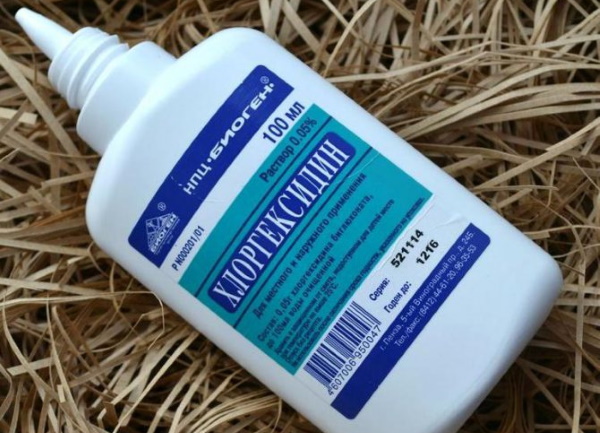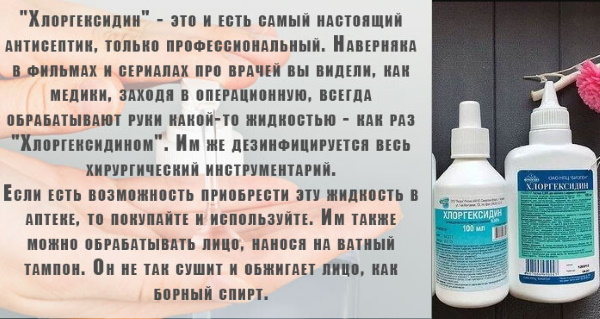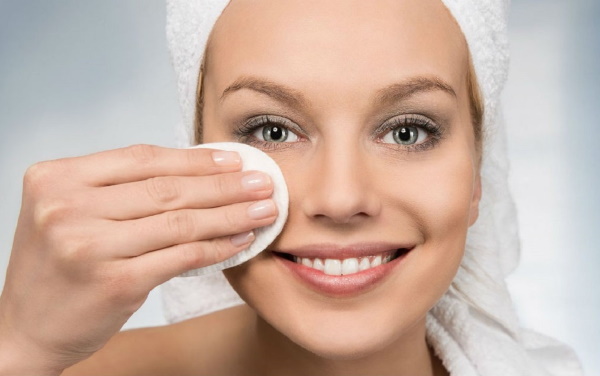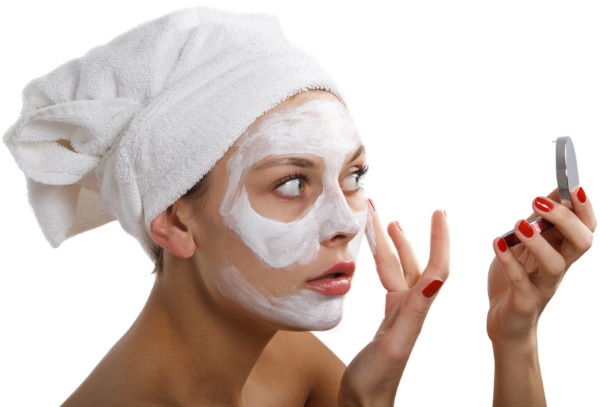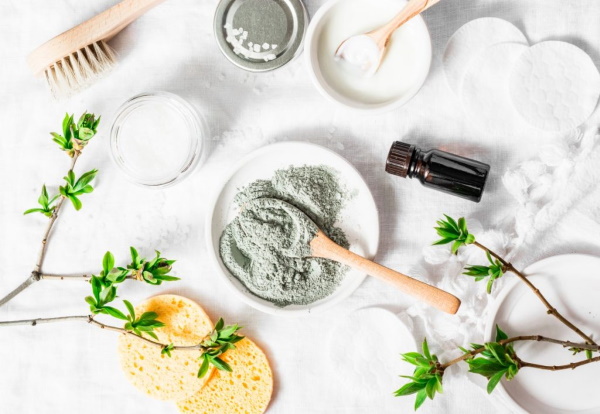The substance chlorhexidine and its salts (chlorhexidine hydrochloride, chlorhexidine digluconate, chlorhexidine diacetate) is found in cosmetic and personal care products such as cosmetics for face, hair dyes, soaps, mouth rinses.
This compound is added as a cosmetic antiseptic, preservative or disinfectant. The substance has a strong bactericidal effect. There are often recommendations to use it against acne, but reviews about its use in this capacity are contradictory, it has contraindications.
Description and composition, where to buy, price
Chlorhexidine is an organic compound with antimicrobial properties that works against bacteria, viruses and fungi. Outwardly, chlorhexidine looks like an odorless white or pale yellow powder, poorly soluble in water and most organic solvents.
Due to the poor solubility of chlorhexidine in water, the salts of chlorhexidine and glucuronic acid (gluconate, dicluconate), hydrochloric acid (hydrochloride) or acetic acid (acetate) are mainly used. Chlorhexidine gluconate is highly soluble in water and alcohol.
Concentrated chlorhexidine gluconate is a colorless or pale yellow odorless solution with a bitter taste. Aqueous solutions of chlorhexidine salts exhibit maximum biological activity and chemical stability at a solution pH of 5 to 8.
Chlorhexidine gluconate is used as an antiseptic at a concentration of 0.5 to 4%. It is registered in the European Union Commission's Cosmetic Ingredient Database and can be used as a cosmetic preservative in a concentration of no more than 0.3%.
Chlorhexidine hydrochloride is included in the composition of tablets for sore throat, it is used to disinfect catheters, as a preservative in creams, ointments and gels. Chlorhexidine acetate is used to disinfect equipment, surfaces and textiles, and is used to make antacids.
Chlorhexidine gluconate is most commonly used.
This compound was first synthesized in 1954 by ICI Pharmaceuticals. Chlorhexidine has been shown to have high antimicrobial activity, low toxicity to body cells, and is well tolerated by the skin and mucous membranes. Therefore, chlorhexidine has become widely used as a topical antimicrobial agent.
Hand disinfectants, when used on intact skin, contain 4% chlorhexidine digluconate, and antiseptics for damaged skin contain 1%.
In obstetric procedures, drugs containing 1% chlorhexidine are used, in dentistry - 0.2% chlorhexidine is part of mouth rinses, and oral gels with 1% chlorhexidine are also used.
Preparations containing chlorhexidine:
| A drug | price, rub. |
| Chlorhexidine bigluconate 0.05%, 100 ml, Samaramedprom, Russia | 55 |
| Chlorhexidine bigluconate 0.05%, SFP, 100 ml Samara factory | 84 |
| Chlorhexidine 0.5% 1 L, Rosbio | 169 |
| Chlorhexidine 0.05% 100 ml, Biogen | 15 |
| Chlorhexidine 0.5% alcohol, spray | 22 |
| 911 skin antiseptic with chlorhexidine, 0.3% | 45 |
5interactions with skin
Chlorhexidine is a cationic surfactant with a broad spectrum of antibacterial activity that also acts against fungi, but to a lesser extent. It destroys the membranes of microbial cells and coagulates their cytoplasmic proteins. At pH 5-8, chlorhexidine salts dissociate, thus forming a positively charged chlorhexidine cation.
This cation binds to the negatively charged bacterial cell wall. Chlorhexidine inhibits enzymes of cell membranes and destroys the interaction of lipids and proteins in membranes, the bacterial cell membrane becomes permeable and the contents of the cell leak out.
At higher concentrations of chlorhexidine (more than 0.01%), cytoplasmic proteins coagulate, denature, and the bacterial cell dies. Mold cells are destroyed by the same mechanism. At high concentration, chlorhexidine destroys the envelope of the virus.
The effect of chlorhexidine lasts for several hours. It is non-toxic at low concentrations and does not irritate the skin.
Chlorhexidine for treating facial skin for 8-12 weeks significantly reduces the amount of acne (acne). An ointment containing chlorhexidine gluconate as an active ingredient reduces the formation of comedones. Acne occurs due to dysfunction of the sebaceous glands and excessive secretion of fatty skin secretions.
If the disease is accompanied by hyperkeratosis, in which the cells of the epidermis are not exfoliated regularly enough, comedones are formed. Secretion is a breeding ground for bacteria, including Propionibacterium acnes. Bacteria multiply in closed pores and cause inflammation.
Antibacterial agents, which include chlorhexidine, act against the bacterial flora, so inflammation is reduced. But these remedies do not cure the causes of acne, this explains the negative reviews about its use.
Some dermatologists also recommend using chlorhexidine on the face and body to treat acne. Other experts believe that chlorhexidine is toxic and should only be used when the benefits outweigh its harmful effects. Chlorhexidine against acne on the back and shoulders: the remedy is quite effective, since the skin in these areas is less sensitive.
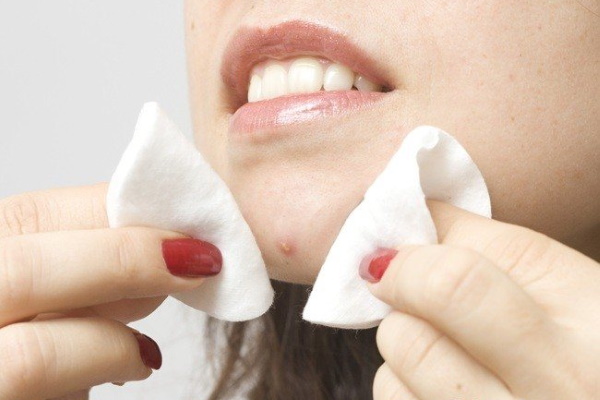
Chlorhexidine for the face (consumer reviews of its use as an anti-acne agent, both negative and positive) are more suitable for skin with intense secretion, that is, for oily skin, or skin of a combination type. Chlorhexidine often causes peeling and irritation on skin with insufficient sebum production and sensitive skin.
Advantages and disadvantages
The product can be used in a wide range of pH values, is effective in organic fluids such as pus, and:
- Chlorhexidine prevents the growth of bacteria not only on contact, but also has a delayed effect, that is, inhibits the growth of bacteria for several hours after application.
- Chlorhexidine for hand disinfection: at a concentration of 4%, a single application destroys 80-90% of bacteria.
- Using chlorhexidine in the oral cavity prevents plaque formation. A single rinse with 0.2% chlorhexidine reduces bacteria in the mouth by 80-95%.
- It is used as a preservative and protects cosmetics from contamination.
- Chlorhexidine gluconate is toxic by ingestion and inhalation. But according to the experts from the Cosmetic Ingredient Review (CIR), chlorhexidine and its salts are safe in the concentrations used in cosmetics. These are concentrations - 0.14%, calculated as chlorhexidine; 0.19% based on chlorhexidine diacetate; 0.20% based on chlorhexidine digluconate; 0.16% - for chlorhexidine dihydrochloride.It is also known that chlorhexidine does not cause cancer and does not have a toxic effect on the reproductive system.
But there are also disadvantages of using chlorhexidine:
- Chlorhexidine can cause skin irritation and dryness in some cases.
- Antibacterial agents destroy the beneficial microflora of the skin, which can destroy its protective barrier. Cleansing hands with chlorhexidine reduces the number of microorganisms on the skin by 86-92%, including the normal microflora of the skin.
- Long-term use of antibacterial agents can lead to the fact that the microflora becomes resistant to these substances.
- Chlorhexidine for the face (reviews of dermatologists are rather negative), according to reviews of dermatologists, is toxic. There is a high risk of damage to the middle ear and cornea of the eyes.
- The skin becomes more sensitive to UV radiation.
- When used in dentistry, there is a change in the color of the enamel, the appearance of tartar.
Indications for use
Chlorhexidine digluconate is used in medical practice to disinfect the surface of the skin of patients before surgery, the surface of wounds, sterilize surgical instruments and treat the skin of the hands of medical personnel. For these purposes, a 1% chlorhexidine solution is used.
A 2% solution is used to treat sexually transmitted diseases, infections of the genitourinary system, for disinfection in gynecology.
Chlorhexidine for the oral cavity: at a concentration of 0.3%, it prevents the appearance of dental plaque, stomatitis. Gargling and irrigation helps against candidiasis and gingivitis. Chlorhexidine for face (consumer and dermatologist reviews are similar) can be used to treat acne, although manufacturers do not indicate this method of use in the instructions.
Application for acne and blackheads
Before treating skin rashes with chlorhexidine, you should consult a dermatologist. For acne treatment, it is recommended to add chlorhexidine to dry cosmetic masks, apply compresses to certain areas of the face, and also wipe the face with a solution of chlorhexidine digluconate.
Compresses:
- Moisten a small piece of cloth, cotton swab or disc with 0.05% chlorhexidine solution.
- Apply an application to the face for 3-5 minutes.
- After the compress, you need to wash your face with warm water, apply a moisturizer.
- Do not reuse the cotton pad or swab.
Wipe:
- To prepare the solution, mix a 0.05% chlorhexidine solution with chamomile extract in a 1: 2 ratio.
- Wipe your face 1-2 times a day for 1-2 weeks.
- Wash with water and apply a moisturizing sunscreen.
Masks
Facial masks that help treat acne are different from regular moisturizing masks. To eliminate acne, masks are best suited to absorb excess oil, draw impurities from the pores of the skin and restore balance. After applying the mask, the skin looks fresher.
Antibacterial ingredients such as charcoal, green tea or a few drops of chlorhexidine are also added to the masks. When using masks, the size of comedones is reduced, in addition to removing excess fat and impurities, it prevents the appearance of acne in the future.
Masks can be used 1-2 times a week for 15-30 minutes.
- Stir a mixture of bodyagi powder and cosmetic white clay with 0.05% chlorhexidine solution. The ratio of the components of the mask: 2 volumes of clay powder, one volume of bodyagi powder.
- Apply the product for 15 minutes. Then wash off with warm water.
- It is recommended to use sunscreen creams after applying the mask.
Tonic
The use of chlorhexidine as a facial toner suggests prolonged daily use. Dermatologists do not recommend replacing the face tonic with chlorhexidine solution, since prolonged use of antibacterial agents in daily care can worsen the skin condition, cause peeling and disrupt the natural balance of microflora.
With cosmetic clay
For the treatment of acne, a peeling agent based on chlorhexidine and blue or black cosmetic clay is used. Cosmetic clay has beneficial properties, it contains minerals and is able to cleanse the skin.
When choosing the type of cosmetic clay, it is necessary to take into account the type of skin.The frequency of the procedure also depends on the type of skin: for oily and combination skin, it is recommended to apply the mask 2-3 times a week, for dry skin - no more than 1 time a week.
- Dilute the clay powder with water until the consistency of a thick slurry.
- Mix the mass with chlorhexidine in a 1: 1 ratio.
- Apply the product to the face and massage for a few minutes.
- Wash off the composition with warm water.
With baby powder
For oily skin care, it is recommended to use a mask consisting of chlorhexidine and baby powder:
- It is necessary to mix the components in a 1: 1 ratio by volume.
- Apply the composition to the face and hold until the mask dries.
- Then rinse off with warm water.
With essential oils
To prepare a facial lotion:
- In a 0.01% chlorhexidine solution, add 3-4 drops of essential oil.
- Any essential oil can be used, but it is better to use oils that have antibacterial properties, such as tea tree or sandalwood.
- The oil does not mix well with the chlorhexidine solution, so shake well before use.
Daily use of chlorhexidine can cause negative effects on the skin of the face. With frequent use of antibacterial agents, bacteria mutate into strains that are resistant to these agents, and in the future, antibacterial agents no longer give a positive effect.
The frequent use of chlorhexidine also has negative reviews due to the excessive formation of sebum. It is recommended to use chlorhexidine no more than 2-3 times a week, or take a course of treatment for 2-3 weeks and then take a break. Since chlorhexidine rarely causes allergic reactions, you should consult a dermatologist before using it.
Video about Chlorhexidine for face
Application of Chlorhexidine for acne:

